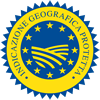Description
The Kiwi Latina PGI refers to the fresh fruit belonging to the botanical species Actinidia deliciosa, deriving from the Hayward variety.
Production Area
The production area of Kiwi Latina PGI is within 24 municipalities in the provinces of Rome and Latina, in the Lazio region.
Production Method
The plant flourishes in cool, deep soil that is well drained and rich in organic elements and minerals like iron and magnesium. For successful pollination, and therefore a good harvest, the male and female plants need to be alternated correctly: five to eight females for every one male. In the period between the end of June and the beginning of July, the fruit are thinned by removing those which present evident defects, so as to leave a maximum of 450,000 fruit per hectare. Harvesting takes place when the Brix value reaches at least 6.2° Bx and its firmness (measured using an 8 mm probe) is no less than 6 kg.
Appearance and Flavour
Kiwi Latina PGI is cylindrical and ellipsoidal with a diameter smaller than its height. It has a brown skin with a light green bottom. The pulp is light emerald green with a soft, off-white core containing numerous small black seeds. It has a firm texture and a typical, pleasantly acidic sweet flavour when the kiwi fully ripens.
History
Although it is known for being a fruit from New Zealand, the kiwi was already well-known in China more than 700 years ago, where it was considered a delicacy at the court of Genghis Khan. More recently, at the beginning of the last century, some New Zealand missionaries brought the first wild Actinidia deliciosa plants to China, where the so-called Chinese gooseberry – as the kiwi was called at the time – was initially considered an ornamental garden plant. The first commercial variety for food consumption was only developed after the Second World War. The fruit’s actual name was only coined in 1959, and originates from the bird that is the symbol of New Zealand. The plant was introduced into Italy in the 1970s and its cultivation spread rapidly, making it the world's leading kiwi producer in a very short space of time. In particular, it was introduced into Lazio in 1971 by Ottavio Cacioppo, who created an experimental plantation in San Felice Circeo (LT), and in 1973 the first plantations appeared in the Province of Latina. In 1978, the first convention on Actinidia was organised in Turin, during which the Pontine agricultural area was mentioned as being particularly suitable for kiwi production.
Gastronomy
Kiwi Latina PGI can be kept in the refrigerator and should preferably be consumed within a few days. If stored inside a plastic bag, it can keep for up to as long as two weeks. It shouldn’t be kept next to other fruit, as this will cause accelerated ripening. It is rich in vitamin C and an excellent antioxidant, and is generally eaten fresh, either on its own or in fruit salads, but it is also an ideal ingredient for making preserves, jam, ice cream, juices, syrups and liqueurs.
Marketing
The product is marketed as Kiwi Latina PGI. It is sold in the commercial categories Extra (weighing more than 90 gr) or First (weighing more than 80 gr), individually or packaged, with the brand of the product affixed to the packaging and each piece of fruit. It is available on the market between January and April, and October and December.
Distinctive Features
The unique characteristics of Kiwi Latina PGI stem from the combination of several elements, including the humid-temperate climate of the area in which it is grown, where there is hardly any frost, and the characteristics of the volcanic soil this is sandy and rich in minerals.

















